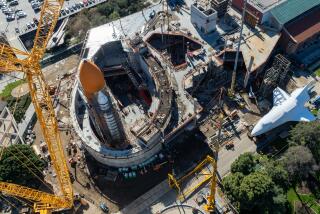Astronauts Get ‘E-Ticket’ Ride to Work
- Share via
HOUSTON — On a leisurely Sunday afternoon in space, the hard hats of “Ace Construction Company” stepped outside the shuttle Atlantis to do a little work in their backyard.
Along the way, mission specialists Jerry Ross and Sherwood Spring joked about Saturday’s football scores, took in the sights unrolling beneath them on Earth and rode the shuttle’s robot manipulator arm.
On their second day of work outside Atlantis, the pair enlarged on their earlier efforts. On that first space walk Friday, they had erected, then disassembled and stowed, a 45-foot-long triangular truss called ACCESS and a 12-foot tetrahedron called EASE.
Anchored to Arm
On Friday, ACCESS was constructed while the astronauts were anchored to a platform in the shuttle bay, and EASE was assembled while they were floating free. On Sunday, both structures were assembled--or partly assembled--by an astronaut whose feet were anchored on the end of the robot arm.
The manipulator arm was controlled from inside the shuttle by mission specialist Mary Cleave, who had been given permission to move the arm twice as fast as on previous flights. Astronauts on those flights had complained of boredom while waiting to reach their destinations aboard the arm.
Ross and Spring apparently were happy with the increased speed. As he dismounted from the arm halfway through their work. Ross, likening the experience to a premium Disneyland ride, said: “That’s definitely an E-ticket ride.”
The pair began by assembling part of the ACCESS truss from the payload bay. Ross then mounted the arm to complete the assembly and to hang an American flag halfway up the structure.
Scientists on the ground hoped to learn whether it was easier to build the structure from a fixed rig in the bay or from the end of the arm.
‘Stringing a Clothesline’
While still anchored to the robot arm, Ross then strung a simulated electrical cable the length of the truss, attaching it with special clips. “It’s like being out in the backyard stringing a clothesline,” he said.
The pair then dismounted the 190-pound truss from the assembly rig so that Ross could maneuver it freely. Spring later performed the same feat.
“It feels very easy,” Ross said as he hefted the tower. “I can go wherever I want to with it.”
Before they disassembled and stowed ACCESS, Spring also removed one of the 4.5-foot struts from an interior bay of the truss, simulating a repair.
After ACCESS was stowed, Spring put together two of the beams used in constructing EASE to make a 24-foot-long, 128-pound beam that is about the same size and weight of heating pipes that would be used in a space station. He then practiced maneuvering it from the end of the robot arm.
First Problem of Mission
Spring then put together the entire 384-pound tetrahedron and maneuvered it. The space walkers ran into their first problem of the mission when they attempted to remount the tetrahedron in the cargo bay. A pin intended to secure one of the corners to the mount could not be reinserted. Eventually, they rejected the idea of hammering the pin in. They simply disassembled the structure without remounting it and brought the balky corner mount into the cabin with them.
The space construction was done with aluminum tubes. The tubes have sockets that permit them to be snapped together like Tinkertoy pieces. The work of Ross and Spring proves that astronauts will be able to assemble major elements of the permanent space station that the National Aeronautics and Space Administration hopes to build in the 1990s.
More to Read
Sign up for Essential California
The most important California stories and recommendations in your inbox every morning.
You may occasionally receive promotional content from the Los Angeles Times.













